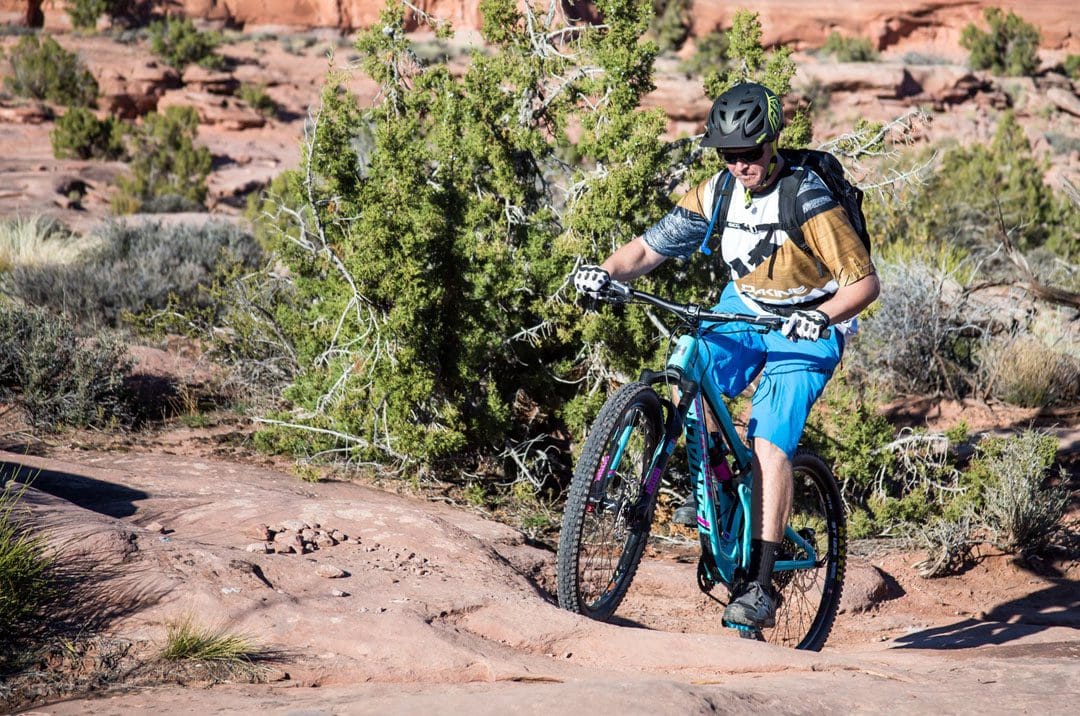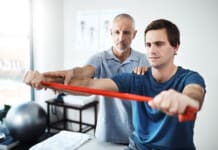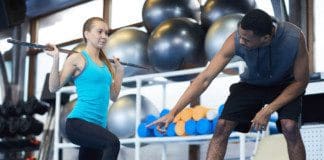Mountain and trail biking is a fun way to exercise. Mountain biking requires total body/core strength, explosive power, balance, endurance, and agility to maneuver the bike, build speed, and absorb the rough bumps and terrain. But it also means that certain muscles get overused, causing overcompensation in the body that can lead to musculoskeletal problems and conditions. Strength, cardiovascular, and cross-fit can benefit mountain biking training for improved performance, safer and more confident riding, and injury prevention.

Table of Contents
Mountain Biking Training
A few of the benefits of training are:
- Increasing bone density.
- Improving joint health.
- Correcting imbalances and unhealthy posture.
- Weight loss.
- Aging muscle loss prevention.
Maintaining body posture centered on the bike requires core strength to perform the movements when moving the body backward and forwards, side to side, and pushing up and down when different obstacles pop up. The exercises’ objective is to work various body parts simultaneously and diagonally, like the movements used on the bike.
General Overview of Mountain Biking Training
- Build strength – Target the quads, hamstrings, and abdominal muscles to power pedaling strokes.
- Increase endurance – Avoid getting fatigued early because of weakened legs and aerobic performance.
- Improve mountain bike skills – Ride faster and more efficiently by improving bike handling and technical skills.
Example Training Week
The terrain determines the intensity, but the same basic principles apply to mountain biking training as other endurance sports. Here’s a training example for a beginner that can be adjusted to the rider’s needs:
Monday
- Stretching and training the muscles to relax prevent becoming stiff or cramping up during rides.
Tuesday
- Beginner small hills trail ride.
- The hills are equivalent to HIIT training.
- Recover on the flats and downhills.
Wednesday
- Light, short ride.
- Focus on pedaling techniques and/or cornering drills.
Thursday
- Medium-length trail ride on flat to rolling hills.
- Keep it conversational pace and enjoy the trails.
Friday
- Recovery day.
- Stretching, massage, and foam rolling.
Saturday
- Long trail ride.
- Go at a conversational pace and have fun.
- Don’t let technique fail when the body starts to get tired.
Sunday
- Medium-length trail ride.
- Go at a conversational pace.
Basic Skills
Practicing technical skills will prepare beginning mountain bikers for success. Here are a few basic skills to get started:
Cornering
- Riding singletrack means making tight turns.
- Cornering is a critical skill that should never stop being practiced and improved.
Cornering Drills
- Pick a corner on a local trail and ride through it until mastered.
- Focus on riding smoothly through the corner, and speed will generate.
- As confidence builds in the corners, do the same on the opposite side.
Straighten Out
- Ride to the furthest outside edge when approaching the turn.
- Initiate the turn just before the sharpest point of the corner.
- Stick to the furthest outside point of the corner when riding out of the corner.
Brake Before The Corner
- Braking in the corner can cause the tires to slide out of control, causing a slip-and-fall accident.
- Look through the turn as the bike follows where the eyes look.
- Don’t stare at the front wheel, which could lead to a falling or flipping accident.
- Eventually, riders can handle this technique, but it’s too advanced for beginners.
Smooth Ride
Beginners can be amazed at how much terrain bikes can ride over and through. Modern mountain bike suspension and tire systems can handle it. However, using the correct technique is essential to get through or around the obstacles and avoid crashes.
- Stay aware of the surroundings.
- Keep the body loose when approaching obstacles.
- Decide how to overcome the obstacle – ride over, pop/raise the wheels, jump, or ride around.
- Maintain confidence.
- When riding over the obstacle, maintain an even balance on the pedals and keep the buttocks slightly off the saddle.
- Keep arms and legs loose and let the body absorb the shock of the obstacle.
- Trust the suspension and tires.
- Ensure enough speed is generated to go over it and that it won’t stop the bike and cause a fall.
- Some rough trail areas can require added strength to hold the bike steady.
Braking
- There is no need to squeeze the brake handles with extreme force.
- Extreme braking, especially the front, will likely lead to a flip or crash.
- The brakes are made to stop with minimal force.
- Beginners are recommended to learn to use a light touch when braking.
- Improvement will follow with each riding session.
Foundation
References
Arriel, Rhaí André, et al. “Current Perspectives of Cross-Country Mountain Biking: Physiological and Mechanical Aspects, Evolution of Bikes, Accidents, and Injuries.” International journal of environmental research and public health vol. 19,19 12552. 1 Oct. 2022, doi:10.3390/ijerph191912552
Inoue, Allan, et al. “Effects of Sprint versus High-Intensity Aerobic Interval Training on Cross-Country Mountain Biking Performance: A Randomized Controlled Trial.” PloS one vol. 11,1 e0145298. 20 Jan. 2016, doi:10.1371/journal.pone.0145298
Kronisch, Robert L, and Ronald P Pfeiffer. “Mountain biking injuries: an update.” Sports medicine (Auckland, N.Z.) vol. 32,8 (2002): 523-37. doi:10.2165/00007256-200232080-00004
Muyor, J M, and M Zabala. “Road Cycling and Mountain Biking Produce Adaptations on the Spine and Hamstring Extensibility.” International Journal of sports medicine vol. 37,1 (2016): 43-9. doi:10.1055/s-0035-1555861
Ranchordas, Mayur K. “Nutrition for adventure racing.” Sports medicine (Auckland, N.Z.) vol. 42,11 (2012): 915-27. doi:10.1007/BF03262303
Professional Scope of Practice *
The information herein on "Mountain Biking Training Beginners: EP Functional Health Clinic" is not intended to replace a one-on-one relationship with a qualified health care professional or licensed physician and is not medical advice. We encourage you to make healthcare decisions based on your research and partnership with a qualified healthcare professional.
Blog Information & Scope Discussions
Welcome to El Paso's Premier Wellness and Injury Care Clinic & Wellness Blog, where Dr. Alex Jimenez, DC, FNP-C, a Multi-State board-certified Family Practice Nurse Practitioner (FNP-BC) and Chiropractor (DC), presents insights on how our multidisciplinary team is dedicated to holistic healing and personalized care. Our practice aligns with evidence-based treatment protocols inspired by integrative medicine principles, similar to those found on this site and our family practice-based chiromed.com site, focusing on restoring health naturally for patients of all ages.
Our areas of multidisciplinary practice include Wellness & Nutrition, Chronic Pain, Personal Injury, Auto Accident Care, Work Injuries, Back Injury, Low Back Pain, Neck Pain, Migraine Headaches, Sports Injuries, Severe Sciatica, Scoliosis, Complex Herniated Discs, Fibromyalgia, Chronic Pain, Complex Injuries, Stress Management, Functional Medicine Treatments, and in-scope care protocols.
Our information scope is multidisciplinary, focusing on musculoskeletal and physical medicine, wellness, contributing etiological viscerosomatic disturbances within clinical presentations, associated somato-visceral reflex clinical dynamics, subluxation complexes, sensitive health issues, and functional medicine articles, topics, and discussions.
We provide and present clinical collaboration with specialists from various disciplines. Each specialist is governed by their professional scope of practice and their jurisdiction of licensure. We use functional health & wellness protocols to treat and support care for musculoskeletal injuries or disorders.
Our videos, posts, topics, and insights address clinical matters and issues that are directly or indirectly related to our clinical scope of practice.
Our office has made a reasonable effort to provide supportive citations and has identified relevant research studies that support our posts. We provide copies of supporting research studies upon request to regulatory boards and the public.
We understand that we cover matters that require an additional explanation of how they may assist in a particular care plan or treatment protocol; therefore, to discuss the subject matter above further, please feel free to ask Dr. Alex Jimenez, DC, APRN, FNP-BC, or contact us at 915-850-0900.
We are here to help you and your family.
Blessings
Dr. Alex Jimenez DC, MSACP, APRN, FNP-BC*, CCST, IFMCP, CFMP, ATN
email: coach@elpasofunctionalmedicine.com
Multidisciplinary Licensing & Board Certifications:
Licensed as a Doctor of Chiropractic (DC) in Texas & New Mexico*
Texas DC License #: TX5807, Verified: TX5807
New Mexico DC License #: NM-DC2182, Verified: NM-DC2182
Licensed as a Multi-State Advanced Practice Registered Nurse (APRN*) in Texas & Multistate
Multistate Compact RN License by Endorsement (42 States)
Texas APRN License #: 1191402, Verified: 1191402 *
Florida APRN License #: 11043890, Verified: APRN11043890 *
* Prescriptive Authority Authorized
ANCC FNP-BC: Board Certified Nurse Practitioner*
Compact Status: Multi-State License: Authorized to Practice in 40 States*
Graduate with Honors: ICHS: MSN-FNP (Family Nurse Practitioner Program)
Degree Granted. Master's in Family Practice MSN Diploma (Cum Laude)
Dr. Alex Jimenez, DC, APRN, FNP-BC*, CFMP, IFMCP, ATN, CCST
My Digital Business Card
RN: Registered Nurse
APRNP: Advanced Practice Registered Nurse
FNP: Family Practice Specialization
DC: Doctor of Chiropractic
CFMP: Certified Functional Medicine Provider
IFMCP: Institute of Functional Medicine
CCST: Certified Chiropractic Spinal Trauma
ATN: Advanced Translational Neutrogenomics














